#especially those that appear in works of classical and world mythology (including retellings)
Explore tagged Tumblr posts
Text
I see a song of past romance
I see the sacrifice of man
I see portrayals of betrayal
And a brother’s final stand
I see you on the brink of death
I see you draw your final breath
I see a man who gets to make it home alive
But it’s no longer you…
*insane strings*
#epic the musical#jorge rivera herrans#the underworld saga#underworld saga#No Longer You#odysseus#tiresias#prophet#blindness#divine sight#my gods. mason olshavsky absolutely killed it as tiresias!#this is by far my favourite sequence from the underworld saga.#(well. this and the pre-chorus in ‘Monster’)#it’s so…catchy!#and there is just so much to dissect in terms of characterisation and foreshadowing!#I have rather a soft spot for seers and prophets#especially those that appear in works of classical and world mythology (including retellings)#homer’s iconic blind self-inserts
94 notes
·
View notes
Text
Tony Stark and Arthuriana
Coming to you by special request, a very long post about 616 Tony's interest in Arthuriana, with a focus on all of Tony's run-ins with Morgan le Fay!
I feel like I should disclaim the extent of my knowledge here, which is that I still haven't managed to read anywhere near every issue of Iron Man -- at least, not yet, anyway -- so I'm just going by the things I know I've read, and Morgan le Fay's Marvel wiki entry is frustratingly under-cited, so it's very possible I've missed something relevant, but I'm pretty sure I've got the big stuff down. My other disclaimer here is that I'm not as big an Arthurian nerd as Tony is, which is to say that most of my familiarity comes from modern retellings -- T. H. White's The Once and Future King, Marion Zimmer Bradley's The Mists of Avalon, Mary Stewart's The Crystal Cave, Rosemary Sutcliff's Sword at Sunset -- and not so much the usual classic sources on the Matter of Britain, though I've read bits and pieces of them.
(This is because I wanted to read versions of them that were as close to the original as possible but so far have not ended up finishing any of them because, well, that's hard. So I've never read the Mabinogion because I do not know Welsh. I've got the Norton Critical Edition of Malory's Le Morte d'Arthur, which is probably the best student edition if you're looking for something without modernized spellings, as I was. I've also got -- well, okay, it's my wife's but I'm borrowing it -- a relatively recent Boydell & Brewer edition (ed. Reeve, tr. Wright) of Geoffrey of Monmouth's Historia Regum Britanniae (History of the Kings of Britain), which is, you guessed it, in Latin with a facing English translation. I haven't gotten very far in it because, in case you didn't know this about Latin texts, the beginning is pretty much always the hardest, so I gave up and read some Plautus adaptations instead. Anyway, if for some reason you too want to read Geoffrey of Monmouth in the original Latin I'd recommend that one, but I can't recommend any particular English translations because I've never read one by itself. I bet you didn't think you'd be getting Latin prose recommendations in this post. I mean, maybe you did; it is me, after all.)
Okay. Right. King Arthur. Here we go.
We've got:
Flashbacks to Tony's childhood in late Iron Man volume 1
A brief discussion of Morgan's origin story and Avengers #187
Iron Man vol 1 #149-150: Doomquest
What If vol 1 #33: What if Iron Man was trapped in the time of King Arthur?
Iron Man vol 1 #249-250: Recurring Knightmare
Iron Man: Legacy of Doom #1-4
Avengers vol 3 #1-4: The Morgan Conquest
Civil War: The Confession
Mighty Avengers vol 1 #9-11: Time Is On No One's Side
In terms of universe-internal chronology, we know from Iron Man #287, from 1992, that Tony has been a fan of King Arthur since childhood. This is an issue of a fandom-favorite arc which features Tony having a lot of childhood flashbacks, including the famous "Stark men are made of iron" line (in #286) that for some reason MCU fandom decided it loved; I mean, seriously, I've seen that quoted in way more MCU fic than 616 fic. But slightly later, in #287, we get an entire page devoted to Tony's love of King Arthur.

The narration reads: "Over the next few years, I learned as my father intended. Discipline of body. Strength of character. But in what free time I was allowed, I worked my way through the school's library. At thirteen, I discovered Mallory [sic], who showed me a whole new world. A world of dedication to a cause greater than oneself. Of chivalry and honor. And the fantastic deeds -- of armored heroes."
The art shows Tony as a child sitting under a tree, reading a book labeled Mort D'Arthur by Mallory [sic] -- no, don't ask me why nobody at Marvel checked how to spell either the name of the book or its author -- and daydreaming of King Arthur, the Sword in the Stone, knights, et cetera. Just in case you somehow missed the extremely blatant hint that we are meant to understand that Tony's knight obsession heavily influenced him becoming Iron Man as an adult, we see one of his armors mixed in with all the drawings of knights. So, yes, canonically Tony is Iron Man at least partly because he's a giant King Arthur nerd, which I think is so very sweet. I love him. He's such a dork!
(This issue is currently in print in the Iron Man Epic Collection War Machine, should you need your own copy.)
This isn't actually the only reference to Tony as a King Arthur fanboy in this era of canon, either; a little later, in IM #298, we see that one of Tony's passwords is actually "Mallory." (Yeah, no, they still couldn't spell. But it's cute.)
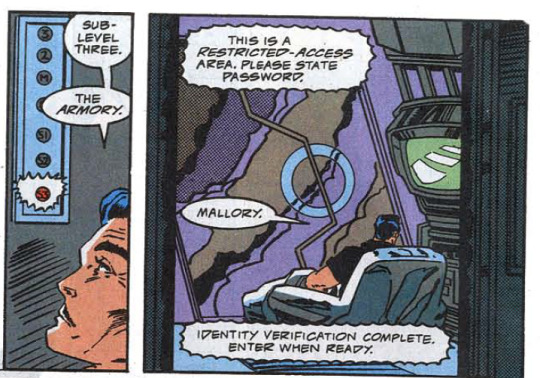
But in terms of actual publication order, this is definitely not the first time we have seen in canon that Tony is into Arthuriana, as I'm sure you all know. I would assume, in fact, that giving Tony a childhood interest in Arthuriana is because Doomquest is one of the most beloved Iron Man story arcs of all time, and that all started at least a decade before IM #287 here was published.
The villain of Doomquest -- the one who isn't Doctor Doom, at least -- is Morgan le Fay. Yes, that Morgan le Fay. Yes, Arthur's evil half-sister Morgan le Fay. Yes, all of this King Arthur stuff is canonically real history on Earth-616. Morgan's first appearance in Marvel, per the wiki, was in Black Knight #1 (1955), which I have not read, and judging by the summary I feel like this is probably just supposed to be a straight-up comic retelling of Arthurian legends for kids; I don't think Marvel really had the whole Marvel Universe in mind as a concept in 1955, so I'm not sure this was meant to connect to anything else. I feel like this is another one of those instances of Marvel discovering that they can write comics about characters in the public domain for free -- like, I'm pretty sure that's how we also ended up with, like, Norse, Greek, and Roman mythology wedged into 616.
As far as I can tell from the wiki, the first time Morgan tangled with the Avengers (or indeed the larger 616 universe) in any way actually predated Doomquest -- it was in an early arc in Spider-Woman (#2-6) and then Avengers #187, which came out in 1979, actually right when Demon in a Bottle was happening over in Iron Man comics. If you read #187, Iron Man is not in it because he's off the team due to his drinking problem and also his accidentally murdering the Carnelian ambassador problem. So Wonder Man's filling in instead. This issue is part of Michelinie's rather sporadic Avengers run, which makes sense, I guess, considering where we see Morgan next.
Anyway, Avengers #187 is the classic issue where Wanda is possessed by Chthon, but what you may not remember from Chthon's backstory (I sure didn't!) is that he was summoned by Morgan le Fay because she was the first person who tried to wield the Darkhold to summon him. As you can imagine, this did not work out especially well for her and her followers and they had to seal Chthon away in Wundagore Mountain, which was where Wanda found him. (The Spider-Woman stuff is only slightly earlier and also appears to be about Morgan and the Darkhold; the Darkhold is not one of the areas of 616 canon I am especially conversant with, alas. It's on my to-read list.)
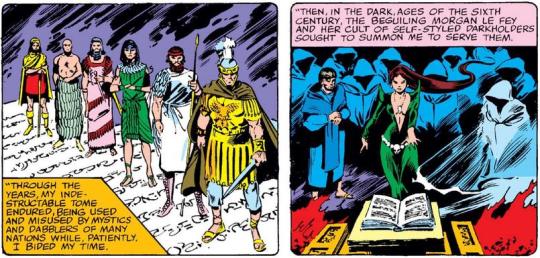
Doomquest, as you probably know, was a classic Iron Man two-parter in Layton & Michelinie's first Iron Man run that set up Tony and Doom as rivals; Doomquest itself was IM #149-150, in 1981, and then in their second IM run they came back and did a sequel in 1989, Recurring Knightmare (IM #249-250), and then the much later four-part sequel to that was the 2008 miniseries Iron Man: Legacy of Doom, which was also by Layton & Michelinie but generally does not seem to be as popular as the first two parts. They've all been reprinted, if you're looking for copies; I have a Doomquest hardcover that collects the first four issues and then a separate Legacy of Doom hardcover. Currently in the Iron Man Epic Collection line there's a volume called Doom, which confusingly only collects the 249-250 part of the storyline (as well as surrounding issues), because for some reason the first Layton & Michelinie run isn't in Epics yet but the second one is. So the beginning of Doomquest isn't currently in print, as far as I can tell. I'm sure you can find it anyway.
So what's Doomquest about? Okay, so you remember how Doctor Doom's mother's soul is stuck in hell for all eternity? Well, Doom's obviously interested in getting her back, and the strategy he has embarked on is to try to team up with other powerful magicians who can help him out, and he thinks Morgan le Fay would be a good choice, for, uh, his quest. Doom's quest. A Doomquest, if you will. (If you've ever read Doctor Strange & Doctor Doom: Triumph & Torment, you're familiar with the part where he later ends up waylaying Strange for this and they go to hell together. And if you haven't read Triumph & Torment, you really should, because it's amazing.)
So Doom is off to his time machine to go team up with Morgan le Fay and Tony thinks Doom is up to something -- Doom has been stealing components for his time machine from a lot of people, including Tony -- and he follows him and it turns out one of Doom's lackeys has a grudge and wants to trap Doom in the past forever, and Tony gets caught up in it. Now they're both in Camelot. Surprise! #149 is actually all setup; they don't get to Camelot until #150.
IM #150 begins with Doom and Tony thrown back into the past; there's a fandom-famous splash page of them locked in combat, only to realize that they have found themselves in Camelot.
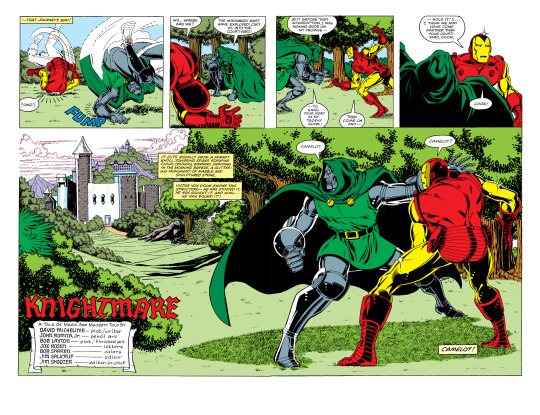
They are then discovered by knights; Doom would very much like to attack them, but Tony, who naturally would be happy to LARP Camelot forever, persuades him to play nice. Also Doom thinks Iron Man is only Tony's bodyguard so he keeps referring to him as "lackey," much to Tony's annoyance. Somehow everyone thinks they're sorcerers. Can't imagine why. The knights take them to meet King Arthur himself, and Tony has clearly had his introduction all ready to go, as he introduces himself in a timeline-appropriate manner, says he's here to apprehend Doom, and demonstrates his "magic" by levitating Arthur's throne. Doom's response is essentially "I'm the king of Latveria," which is, y'know, also valid. So they're guests at Camelot for the night while Arthur figures out what to do with them.
We then have a page devoted to Tony alone in his room, musing sadly about how alien he feels, how he doesn't know if he'll ever get home, how he could never fit in here without his beloved technology. Then a Sexy Lady shows up to keep him company for the night, and he decides maybe it's not all bad. Thanks, Marvel. I guess they can't all be winners.
Doom is using his evening much more productively; he compels one of the servants to tell him where Morgan's castle is, because he's still interested in having that team-up. Then he jets off. Literally. He has a jetpack.
The next morning Arthur's like "one of you is still here and one of you has punched a hole through the castle wall and flown off to join Morgan so I guess I know which of you is more trustworthy." He then explains to Tony who Morgan is, because Tony professes ignorance, because clearly we had not yet retconned in Tony's love of Arthuriana. Tony offers to go fight Doom and Morgan with Arthur; meanwhile, Morgan and Doom have teamed up and Morgan has offered to help get Doom's mother out of hell if he commands her undead armies against Arthur because for Reasons she can't command them herself anymore. So that's a thing that happens.
So, yes, it's Tony and Arthur versus Doom and Morgan. Fight fight fight!

Tony tries Doom first but then decides to hunt Morgan down, and in the ensuing fight we get what I think is Tony's first ever "I hate magic," a complaint that we all know he still makes even to this day.
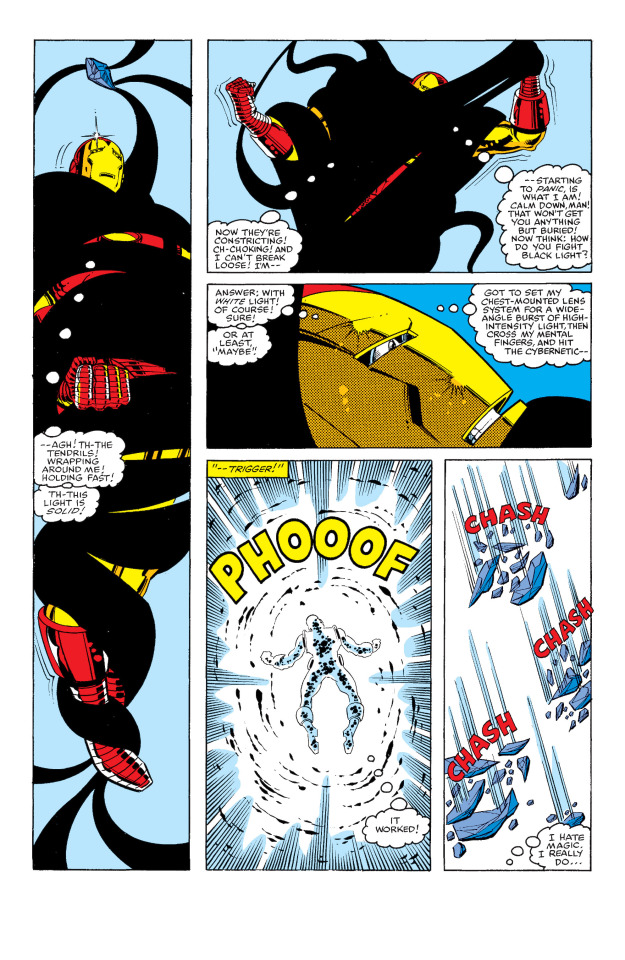
Anyway, Tony freezes a dragon with Freon (mmm, technology) and Morgan gets upset and disappears, so the battle comes to an end, and of course Doom is extremely mad at Tony because he blames Tony for Morgan not sticking around to save Doom's mom, because I guess Doom trusted her to keep her word? Weird. (Like I said, for the next chapter of Doom saving his mother, go read Triumph & Torment.)
Doom says if he and Tony work together, the components in both of their armors can send them both home. So Tony has to trust Doom. Which he does, because he really has no other choice. They build a time machine and Tony makes Doom agree to a 24-hour truce when they get back, so they can both get home. So it all works out okay, and they end up in the present, and Doom tells him, ominously, that they will meet again. Okay, then. That concludes the original Doomquest. It's fun! You can see why fandom likes it.
So that's all well and good, but you might have noticed that Tony's ability to get home hinged on Doom actually being trustworthy. And Doom was. But what if Doom hadn't been? What if he'd just stranded Tony in Camelot forever As you may have surmised from the form of that question, that is in fact a question Marvel asked themselves, because, yes, there's a What If about this! What If v1 #33 is "What if Iron Man was trapped in the time of King Arthur?"
The divergence point from canon, as you can probably guess, is the very end of Doomquest. Instead of Doom bringing Tony home, he deceives him and leaves him in Camelot. And since Tony cannibalized a lot of the tech from his armor to make the time machine, he doesn't have a way to go home.

This is not a story where Tony comes up with a way to go home after all. He really doesn't get to go home. But instead of drowning his sorrows in mead -- because, remember, Demon in a Bottle has already happened and Tony is sober now -- he decides he might as well just play the hand he's dealt. So with what's left of his armor, he defeats some enemies that Morgan rounds up to send against Camelot. And for his services, he's knighted. He is now Sir Anthony.
Tony acknowledges that he is both living the dream and would also like very, very much to go home.
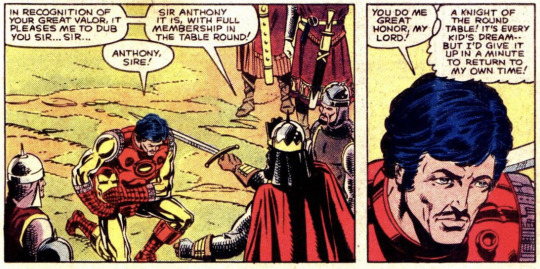
He does end up having some fun in Camelot; it's not all miserable. But he obviously doesn't want to be there.
So if you're at all familiar with King Arthur, you know how this goes, right? Arthur fights Mordred and Mordred kills him. And that does happen in this version. Except Tony is right there, and with his dying words, Arthur asks Tony to rule Camelot... and Tony agrees.
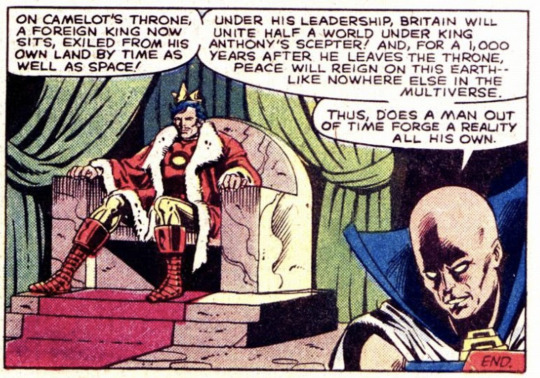
So, yes, Tony Stark becomes king of the Britons after Arthur's death and he never goes home again. The end. Man, I love What Ifs.
Heading back to main 616 continuity, there is still more of this arc to go. The original Doomquest was only two issues, yes, but it was popular enough that Layton & Michelinie did a sequel a hundred issues later, in their second run of Iron Man, and that's Iron Man #249-250, Recurring Knightmare. (In the intervening issues were Denny O'Neil's IM run, specifically the second drinking arc (#160-200), and then Layton & Michelinie came back and most famously gave us Armor Wars (#225-232). I would have to say that Armor Wars is definitely the standout fandom-favorite arc of their second IM run; for their first one, I think a lot of people would have a hard time choosing between Doomquest and Demon.) But anyway, yes. Recurring Knightmare.
Recurring Knightmare is... well, the best way I can describe it is "a trip." It is definitely a sequel to Doomquest, and it is also definitely not a sequel you would ever have expected to see for Doomquest.
Much like #149, #249 is pretty much just setup. Fun setup, but the big action is in the next issue. We open with Doom in Latveria, on his throne, pondering which of his servants he should have disintegrated. Anyway, he's just hanging out there when a mysterious object appears. In California, Tony is suited up and entertaining the crowd at a mall opening when the same object also appears! He takes it to his lab. Please note that this is after the Kathy Dare incident, so Tony is still recovering and is walking with a cane. Doom sees on the news that Iron Man has found the same object, which cannot be carbon-dated, and he shows up at Tony's house. He criticizes Tony's taste in art.
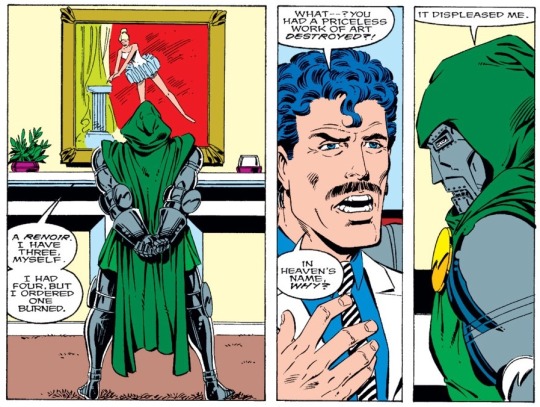
Anyway, Doom basically orders Tony to work with him. Tony refuses, and then Doom sends some robots to attempt to steal Tony's version of the object because he thinks if he has them both he will be powerful. Doom manages to steal it, and when he puts the pieces together, both he and Tony disappear.
So where do they go, you might ask? Camelot?
Not exactly. The future! There is a great callback to the Doomquest splash page.
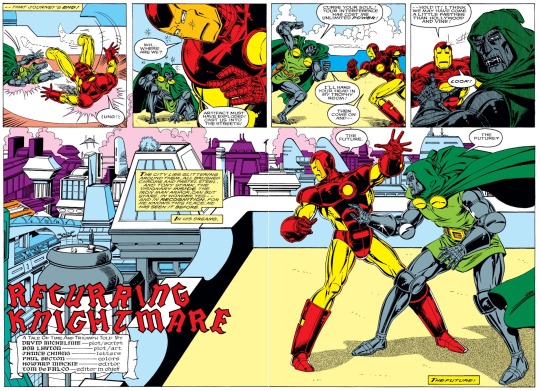
It turns out they are in London in 2093. Merlin brought them there. Tony still hates magic. And in the future, King Arthur is still there, except he is now a child, because he has been reborn. But he does remember Tony from Doomquest, at which point Tony kneels. Doom, of course, is not impressed. He asks why they have been brought to the future.
The answer is that things are going wrong in the future. If you do not personally remember United States politics in the 1980s, I need you to google the words "Strategic Defense Initiative" right now. I'll wait.
Back with me? Okay, so this is a future where Reagan's Star Wars program actually happened the way he wanted it to, and the satellites are still hanging around the Earth in the future and messing everything up, and Arthur and Merlin need Tony and Doom's help to stop them. Doom once again flies away with his jetpack, of course.
Tony is game to help, but he's not in an armor that can stay in space for long. This is when Merlin takes him and Arthur to the mall and Tony manages to get everything to upgrade his armor at Radio Shack. You see what I meant about this issue being weird.
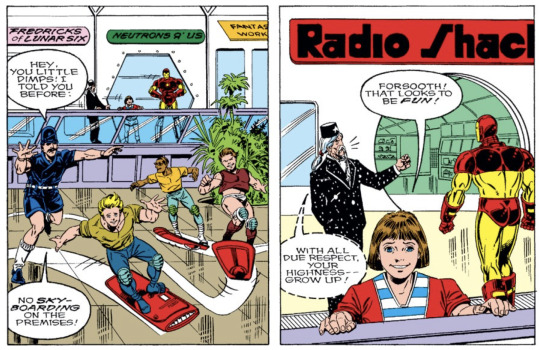
Tony is out in space trying to disarm the SDI platform, which is where he runs into his future descendant, Andros Stark, who is in armor you will probably recognize from Iron Man 2020. He is referred to as "the resurrected spawn of Iron Man 2020" so I assume he's actually directly related to Arno rather than a direct descendant of Tony; Wiki confirms that Arno is his grandfather. This is all from way before Arno was contemporaneous with Tony in canon. Anyway, he's fighting Tony.
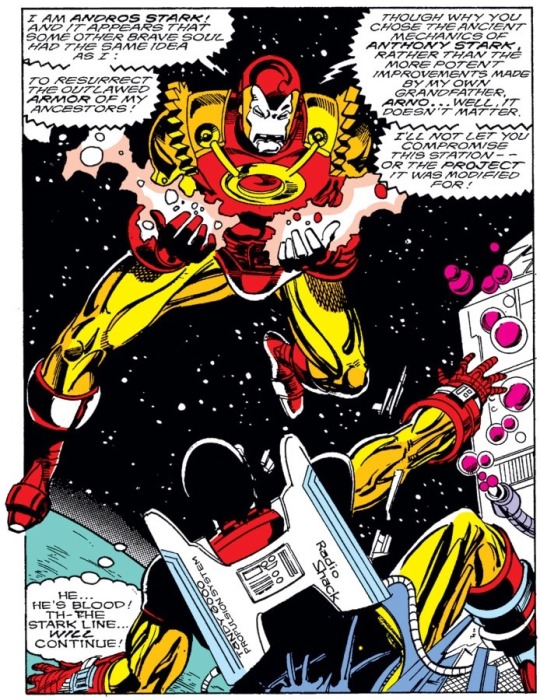
Oh, by the way, Future Doom exists. Future Doom would like to rule this future Earth and for some reason Andros would like to help him. Meanwhile, Present Doom finds out from Merlin that he can't leave except by magic and he can't leave without Tony, so he is reluctantly on Tony's side.
They need help from the Lady of the Lake, except the lake has been paved over and is now a parking lot. Merlin makes the lake come back and then of course they get Excalibur. Arthur is a kid, so he can't wield a longsword; Doom assumes he's going to take it because he is basically a king, and he's pretty grumpy when the sword picks Tony. Tony then uses Excalibur to destroy the space lasers, and I bet that is a sentence you never thought you would read. It's pretty cool. Tony concludes that magic has its good points. Tony stops Andros and Doom stops, uh, himself, and the world is saved and they get to go home. Also, Doom finds out Tony is Iron Man, but when Merlin sends them back he conveniently erases their memories, so neither of them remember anything about this and Tony's secret is still safe. And that's the sequel to Doomquest.
And if you think that's weird, wait until you see Legacy of Doom.
Iron Man: Legacy of Doom is a four-issue miniseries from 2008, also by Layton and Michelinie. Even though it's from 2008, it's set during a much more classic time in Iron Man, continuing on from where we left off in this Doomquest saga. We start with a framing story in 2008. Tony, who has Extremis now, is busy scrapping some of his older armors and reviewing his logs when he suddenly remembers that there was a whole thing with Doom that happened that he seems to have forgotten about until right now. So the whole thing is narrated by Tony in flashback.
Tony's in space fixing a satellite when a hologram of Doom shows up and summons him to Latveria. It's not really clear why Doom needs Tony's help in particular here, but Doom tells Tony that he's discovered that Mephisto would like to bring about the end of the world, which Doom finds, and I quote, "presumptive." So Doom has his Time Cube, and with it he takes Tony to hell.
(Yes, I promise this is relevant to Doomquest. There will be some Arthuriana shortly.)
Doom brings Tony to Mephisto, and it turns out it's a setup! Doom trades Tony for an item he wants from Mephisto, leaves, and Tony's going to be trapped in hell forever! Oh no! (I mean, he's not. But it's quite a cliffhanger.)
At the beginning of issue #2, we find out what the Arthurian connection is, which is that we learned that after the events of Doomquest, Morgan had been granted sanctuary by Mephisto in exchange for a shard of Excalibur that she had somehow stolen. Doom still wants Morgan's help with some magic -- he doesn't mention what it is here, but he says he needs someone of Pendragon blood, and that'd be her -- so he traded Tony to Mephisto in exchange for, I'm guessing, Morgan and the Excalibur shard.
I have probably mentioned this elsewhere, but Legacy of Doom #2 is one of my favorite issues of Iron Man ever, solely because of the next scene. We return to Tony in hell. Howard Stark is also in hell, and he is now a demon, and Tony has to fight him. Mephisto brings popcorn and watches. This is the one time in canon when Tony actually confronts his father, and okay, yes, it's a fistfight in hell and Howard is a demon, but that's comics for you. Howard spends several pages insulting Tony -- specifically insulting his masculinity, but that's a whole other essay -- until he finally insults Maria too, and that's when Tony fights back, because his mother taught him to be good. Honestly if you're a Tony fan I'd recommend this issue just for that scene.
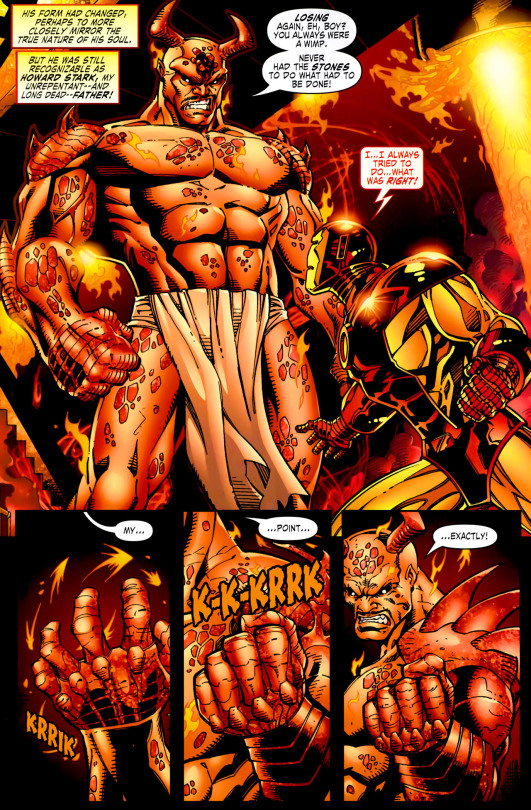
Anyway, we go back to the Doom and Morgan plot, and Morgan casts the spell Doom wanted, which was fusing the Excalibur shard with Doom's armor. Then Doom sends her back to Camelot rather than hell, because he's still mad that she never helped him get his mom out of hell like she said she would.
Tony freezes Howard with Freon -- yes, the same trick he pulled on the dragon back in Doomquest -- and tells him, "You're no father of mine." It is immensely satisfying.
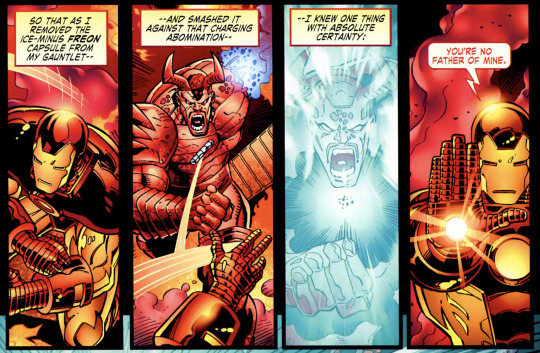
(I had been going to mention that I thought it was a shame that neither canon nor fandom seems to have really engaged with this confrontation, and I know canon never believes in narrative closure but fandom sure does -- and then, anyway, it occurred to me that since the framing story of Tony remembering this is set when Tony has Extremis, there's a very good chance that he no longer remembers remembering it. Goddammit, Marvel.)
(If I got to retcon one canon thing about Tony, I think "the entirety of World's Most Wanted" is up there. I mean, okay, a lot of things are up there, but WMW is definitely on the shortlist.)
Okay. Tony has now engineered his way out of hell, and he's back with Doom in Latveria. Doom has Excalibur. Doom would very much like to fight him. While wielding Excalibur. You get the sense that this is going to be bad. Another cliffhanger!
Legacy of Doom #3 opens with Tony destroying Doom's lab to buy time and running away from Doom and Excalibur. I should probably mention that Doom still doesn't know Tony is Iron Man (anymore), so he thinks he is dealing only with Iron Man, Tony Stark's lackey. Meanwhile, some scientists at SI think there's something weird going on with space. Meanwhile meanwhile, Tony is in a forest taking a breather when a mysterious old man walks up to him.
It's Merlin! Surprise! Merlin wants Tony's help to stop Doom from doing whatever he's doing with Excalibur. The sword makes you invincible and the scabbard makes you invulnerable, so Merlin sends Tony to Scotland on a fetch quest for the scabbard. Doom has now magically sent the sword in search of the scabbard, so the sword flies away to meet it and Doom follows. Turns out the thing that's wrong with space is a thing that's going to hit Earth at the exact place Tony and Doom are. What a coincidence! So Tony and Doom get trapped in a stone circle and fight some stone warriors and then Tony ends up with the scabbard. And by "ends up with," I mean it fuses to his armor. Next issue!
Legacy of Doom #4 is when things really, really get weird. A giant demon made of eyes (???) appears, and this demon is apparently what Doom had been preparing to fight (because it's mad that Doom stole one of its spellbooks), and now he can't, because the sword and the scabbard aren't together. Thanks, Shellhead.
That's when Merlin shows up and says all is not lost. They can defeat the demon... if they put the sword into the scabbard.
"But I'm the scabbard now!" Tony says, uncomprehending.
"Yes," Merlin says. "You are."
Then Tony gets it.
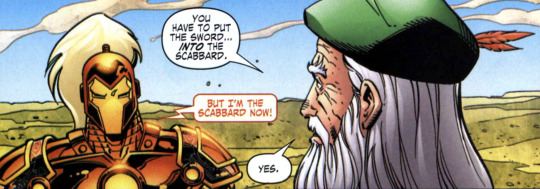
So, yes, Doom has to, um, penetrate Tony. With Excalibur. I love comics. I love comics so much.
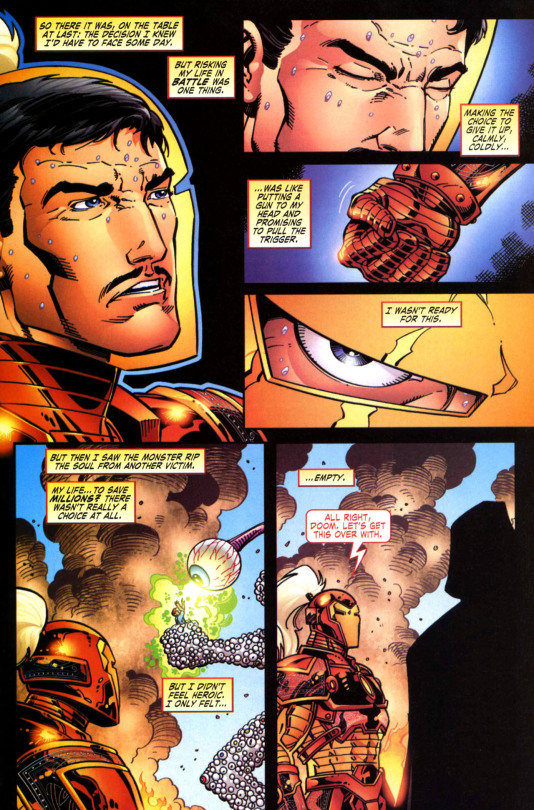
So that's a thing that happens.
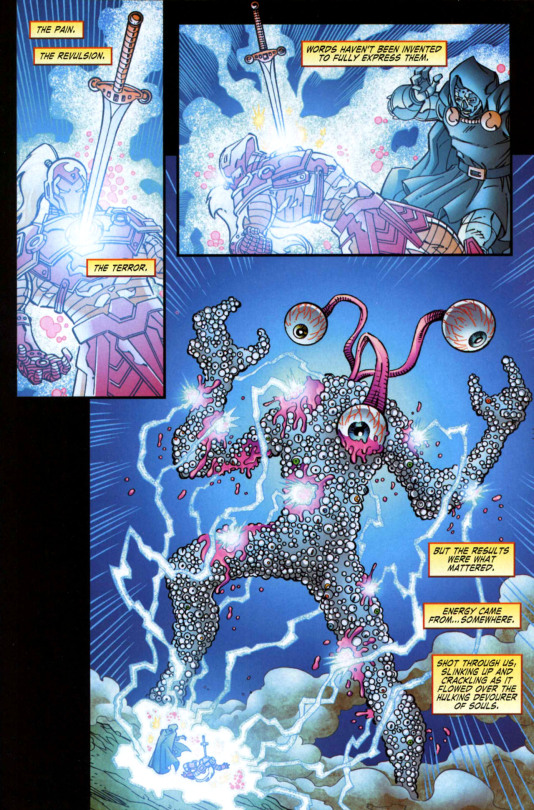
And then Tony flies off and, I guess, resolves to never, ever think about any of this again.
We head back to the framing story, in which Tony, now having remembered all of this, flies to Britain, buys the land the lake is on, and paves it over, presumably so it will be there for Merlin to bring back in Iron Man #250. The end.
Whew.
Okay, yeah, I know I didn't have to summarize the whole thing, but Legacy of Doom here really is one of my favorite Iron Man miniseries. And I just want to share the love. Please read it. It's great.
But the Arthuriana fun doesn't end there! In fact, now we get an Arthurian-themed arc that actually isn't in Iron Man comics. It's in Avengers! Iron Man is involved, though.
(There is also apparently a Morgan arc in Avengers #240. I actually haven't read it. It seems to be yet another Spider-Woman arc. I get the impression that this isn't really Arthuriana other than having Morgan in it fighting Jess, though, so it doesn't seem quite as relevant. Morgan also apparently has some appearances in FF, Journey into Mystery, and Marvel Team-Up, but those seem like more of just basic villainy. Also, probably not involving Tony.)
Kurt Busiek's 1998 Avengers run, volume 3, is in large part the kind of Avengers run that is a nostalgic love letter to older comics. Heroes are heroes and villains are villains and good triumphs over evil. The Avengers all live in the mansion and are BFFs. I love it. It does assume that you are already a fan of the Avengers, because it starts out by summoning pretty much everyone who has ever been an Avenger and is available to the mansion, and that is... a lot of people. Thirty-nine, by my count. Also, when the entire team is magically whisked away, we are treated to the following narration, as Steve disappears: "And Captain America's last thought, as the world goes white around him, and he with it -- is that Iron Man would hate this."

The narration doesn't tell you why Iron Man would hate this, or how Captain America would know that Iron Man hates this. This is not explained later on. But if you have read comics -- or if you have read the above summary of Doomquest -- you know that Tony is absolutely, one hundred percent, thinking, "I hate magic." And Steve knows it.
The reference is not relevant to the plot; if you don't get it, you'll be fine. But that's what I mean when I say this is a nostalgia run. There are definitely Easter eggs for people who have read a bunch of comics. Busiek does this a whole lot in his work -- there's a reason you can buy an annotated edition of Marvels -- and, yeah, it happens here too. Just know that there will be references you're not getting, if you're new to comics.
Anyway. So Busiek's run actually starts out with an Arthurian arc, #1-4, "The Morgan Conquest." The name is a dead giveaway. Yes, Morgan le Fay is back. Again. For once, Doom is not involved.
The Avengers are all back from their sojourn on Counter-Earth after fighting Onslaught -- don't worry about it -- and mysterious things are happening. There are a lot of monster attacks. So pretty much everyone who has ever been an Avenger is summoned to the mansion, at which point we learn from Thor about some mystical artifacts that are being stolen. (They are the Norn Stones and also the Twilight Sword. That sounds like something from a Zelda game, doesn't it?) The Avengers go to try to stop this, end up in Tintagel, and then they run into Mordred. He wants to capture Wanda, presumably for Magic Reasons. Morgan le Fay casts a spell on all of them, reshaping reality. Yes, all of them. Surprise!
So now all the Avengers are living in a medieval castle and/or town; Morgan is their queen, and thanks to the power of mind-control they are all basically living in Ye Olden Times. The Avengers are all some variety of knight, except for Wanda, who is chained up in the dungeon so Morgan can steal her magic and use it to fuel all this reality-warping.
Wanda calls for help, and that snaps Steve (Yeoman America!) out of the mind control (or altered reality or whatever you want to call it) pretty fast, because Steve's always been very good at resisting mind control, and then Steve promptly goes and snaps Clint out of it, because I guess Steve is also good at inspiring people to snap out of mind control. "Oh, man!" Clint says. "Not another alternate reality! Not again!" (I assume he's referring to Counter-Earth? Maybe?)
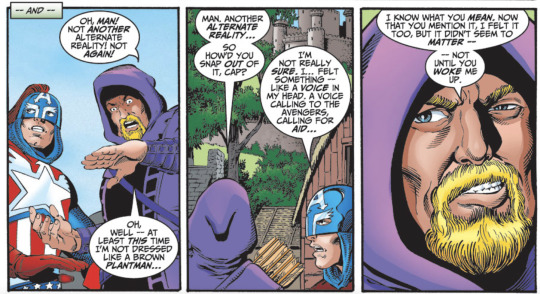
So Steve and Clint go around reassembling the Avengers and orienting them as to reality. They get Jan and Monica easily, but then Steve insists on trying to get Tony because, I guess, he likes Tony and would really like to hang around Tony, who is half-naked and asleep in his bedroom, and certainly I am reading nothing whatsoever into this. Clint tells Steve it's not going to work. Tony has historically been fairly susceptible to mind control; it was only pretty recently at this point that he'd been doing Kang's bidding in The Crossing. But the more serious impediment is that this is Tony Stark and he would obviously like to LARP being a knight forever and ever. Tony, therefore, does not believe Steve, and throws him and Clint out of his bedroom and into the barracks.
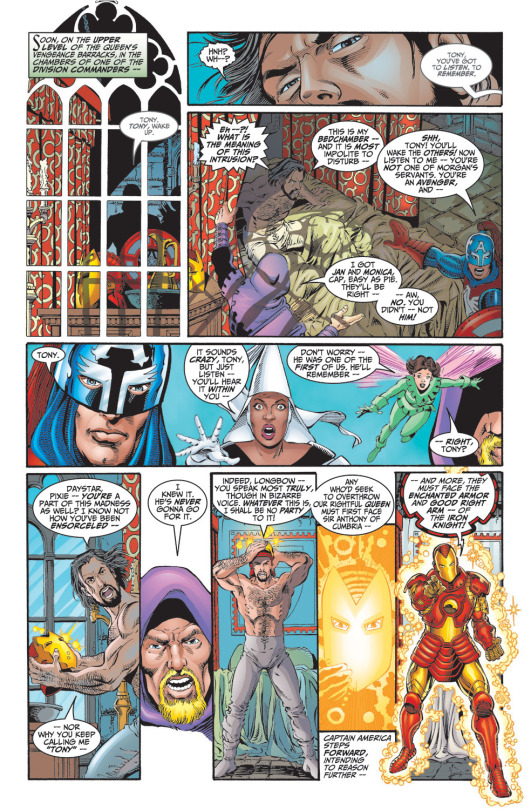
"Iron Man's a good guy, normally," Clint says. "But he's waaay too into his whole nobleman/lord of the manor trip. That spell musta hit him right where he lives!"

Clint speaks the truth, clearly.
Anyway, they go around and manage to make pretty much every Avenger in the room other than Tony snap out, and attempt to rebel against Morgan while Tony is stil fighting them because he is Still A Knight. There's a lot of punching, because some of the Avengers still aren't free; they weren't ones Steve found.
The day is saved when Wanda manages to channel Wonder Man and break free. This gives the Avengers a fighting chance against Morgan and the Avengers are all lending Wanda their power when Tony finally snaps out of it and is on the side of good.

Then they take Morgan down, go home, and attempt to figure out which of these thirty-nine people should be on the active Avengers team. Hooray.
But that's not the end of Morgan le Fay showing up to screw around with Tony's life! There's more to come! Not much, but there is one that I know of, and at least one more memorable reference.
(I haven't read all her appearances or anything, but one of them definitely involves Tony; I can't swear that he doesn't appear in any of the other books Morgan shows up in, but it'd be a cameo for him, because I only know of one more arc that she's in in a book that Tony stars in.)
In a few more years, we have now entered the part of Marvel Comics history where Brian Michael Bendis writes all the Avengers books at the same time for, like, seven years running. It was sure A Time. There were a lot of word bubbles.
And the thing about Bendis is, Bendis looooooves Doomquest. If you're familiar with the very end of his tenure at Marvel where he made Doom be Iron Man after Tony got knocked into a coma in Civil War II, you have probably figured out already that he likes Doom. But he also likes Doomquest, specifically.
I mean, if nothing else, the giant splash page in The Confession where Maleev redrew the climactic Doomquest fight while Bendis had Tony talk about how deeply meaningful to his understanding of the world this all was -- and how it allowed him to predict Civil War -- was probably a big clue, right?
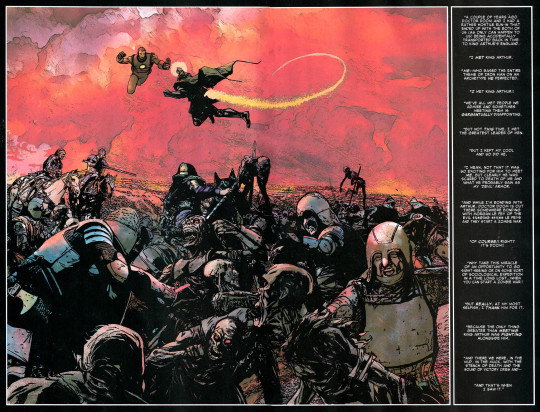
As far as I am aware, Morgan le Fay makes exactly one more appearance in Tony's life. And that's in Mighty Avengers vol 1 #9-11. Only one of those issues is named, so I'm going to assume the arc is named after it: Time Is On No One's Side.
You remember Mighty Avengers, right? The deal with the Avengers books at the time was that after Bendis exploded the mansion and made the team disband in Avengers Disassembled, the main Avengers book was no longer called just Avengers. Instead, the main Avengers book was New Avengers, and that was the only Avengers book. Then Civil War happened, Steve got killed, and New Avengers became the book about what was left of the SHRA resistance (i.e., Steve's side) after the war. So about halfway through New Avengers, Mighty Avengers starts up, and Mighty Avengers is about an extremely fucked-up and grief-stricken Tony Stark trying to run the official government-sanctioned Avengers team, with Carol's help. This is the comic with the arc where Tony turned into naked girl Ultron. You remember.
So, anyway, there's this Mighty Avengers arc where Doom is Up To Something (there are symbiotes and a satellite involved) and somehow Tony and the Avengers end up in Latveria, punching Doom. Also, by the way, Doom is visiting Morgan in the past because he likes her. The Avengers attacking his castle made him have to come back to the present, so he's kind of cranky. And he fights Tony, and in the course of the fight, his time platform explodes and sends Doom and Tony and also the Sentry to... the past.
This is one of those times where you should definitely look up the comics if possible because the way the past is visually indicated here is that it's colored with halftone dots the way you would expect old comics to be colored, although they have modern shading and color palettes. It's very charmingly retro.

So the three of them are stuck in New York in the past, and naturally they would like to leave. There's one person in this time who has a time machine and it is, of course, Reed Richards. Doom and Tony have a lot of banter in this arc; I think it's entertaining.

Sentry has to be the one to break them all into the Baxter Building because of that power he has where no one will remember him. So they do that, travel forward in time, and end up in Latveria in the present again except Doom is gone and also things are currently exploding where they are.
Doom, of course, has made a side trip to visit Morgan again and he asks her to help him build an army, because I guess this is what their relationship is like. So the rest of the Avengers are captured by what look to me like Mindless Ones and are in a cave in magic bondage, because comics. Jess comments that at least they aren't naked, because she too is remembering that memorable New Avengers trip to the Savage Land. Doom threatens Carol in some creepy sexist ways and eventually it turns out that Tony and the Sentry are fine and everyone kicks Doom's ass. Business as usual.
And the last page of the arc is Morgan alone, wondering where Doom is. So technically Morgan and Tony don't come face to face here, but I think she counts as being at least partially responsible for ruining Tony's day here. And then Secret Invasion happens and Tony has a very, very bad day.
There are a few more Morgan appearances after this, but, as I said, I don't think any of them involve Tony. She shows up in Dark Avengers, apparently, which was one of the post-Civil War Avengers titles I didn't read, and I know that recently, on the X-Men side of things, she's been in Tini Howard's Excalibur one, which I have only read a little of. No Tony there. Just a lot of Morgan and Betsy Braddock and Brian Braddock and the Otherworld.
If you are interested in Morgan's other appearances, you might like this Marvel listicle that is Morgan le Fay's six most malicious acts. I pulled some of the Darkhold backstory from their discussion, but it's not really focused on Morgan and Tony.
So there you have it! That's everything I know about Tony's love for King Arthur and every run-in I know about that he's had with Morgan le Fay! One of two terrible people in Tony's life named Morgan! Actually, I don't think we've seen Morgan Stark in a while. I wonder if he's alive. There should be a Morgan & Morgan team-up. I should probably stop typing and post this.
The tl;dr point is that you should all read Doomquest and its sequels, especially Legacy of Doom. They're great!
67 notes
·
View notes
Text
The Death of Love and the Lonely Soul: Eros and Psyche in a Post-TROS World
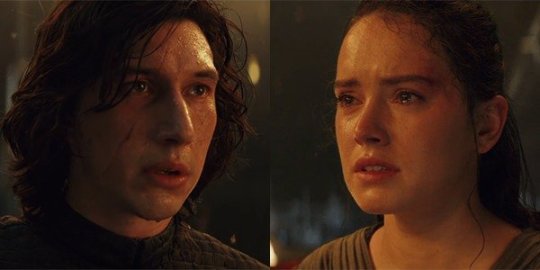
This is the first of my follow-up posts to my series on Folktale Types in Star Wars, focusing on how the Sequel Trilogy retells (or fails to retell) the Eros and Psyche myth, and the potential psychological implications for our culture. This essay will frequently reference my original Reylo as Eros and Psyche post, though I will also occasionally refer to my other Search for the Lost Husband posts (2) (3) (4), so please consider reading those before diving in here.
To explain why I had a great deal of confidence in TROS being a classic happy ending to a Search for the Lost Husband tale (ATU 425), I have to share a little bit of what I learned about how folklorists view these tale types. A century ago, the popular theory about why myths and folktales were so similar all over the world was evolutionary: it assumed there was one origin tale, and that as humans traveled, they would carry the story with them and it would be retold and adapted by other cultures. This suggested there was one ancestral tale from which all the others developed, which accounted for the recurrence of the story’s basic plot and motifs.
Since then, however, advancements in anthropological research and the increasing appreciation for folklore in the study of human psychology has debunked the old evolutionary theory. It was discovered that cultures and societies existing at the same time in history, on opposite sides of the globe and which could have had no possible contact with one another, still told the same tale types with the same motifs. Details might be changed, but every culture had animal husband tales, or animal bride tales, and so on. This led to the now widely-accepted idea that universal human psychology accounts for the similarity in folktales. Basically, all humans tell each other the same stories because we all wrestle with the same fundamental truths, challenges, and transitions. This is why the swan maiden tales can be traced to male anxiety over sexual performance or the prospect of losing a wife in childbirth, or why animal husband tales can be traced to female power fantasies of taming a mate in a patriarchal society.
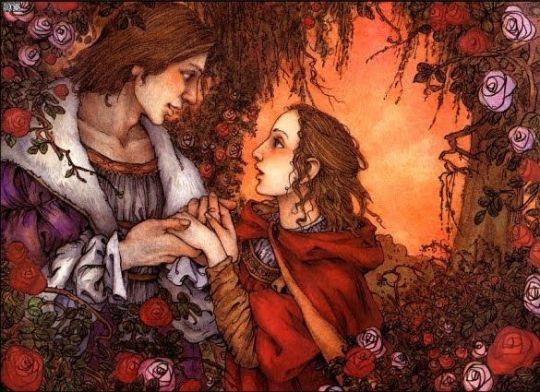
Based on all this, I assumed that even if Terrio and Abrams made a typically vapid modern action flick, they’d still hit all of the main beats of the Eros and Psyche myth because that’s what would come naturally to them. Obviously, Beauty’s love will return the Beast to his human form. Obviously, Psyche will complete her journey from child to adult and take her place as the true or metaphorical mother to the next generation. Obviously, they will end the story united for eternity to signify the end of the galaxy-wide conflict and the beginning of the true peace so long sought by the heroes of the Skywalker Saga.
While this was true to a limited extent in The Rise of Skywalker, several of the reveals and the final moments of the film not only departed dramatically from the structure of the Search for the Lost Husband myth, but the movie even fails to align with the commonly more sorrowful Quest for the Lost Bride. In a cruel and baffling twist, the story erases its hero and returns its heroine to childhood in a barren underworld. There is, frankly, no historical folktale I can find that matches this pattern. Even stories featuring preadolescent children are about disassociation from parental figures, not deeper dependence. (Note: Marie-Claire and Ty Black of What The Force and Wit and Folly have done some exploration of how TROS reflects the so-called “American Monomyth.” This is a valid interpretation but for the purposes of this analysis, I’m continuing to use stories more commonly recognized by the Aarne-Thompson-Uther classification of folktales.)
Rey’s Regression and Psyche’s Tasks
As a quick refresher of where we stood in alignment with the myth by the end of The Last Jedi, Rey is the mortal woman Psyche, and her force powers are akin to Psyche’s beauty in the myth. Kylo Ren/Ben Solo is god of desire Eros, Psyche’s husband and the son of god of war Ares and goddess of love Aphrodite. In Star Wars, it is the Dark Side and dark force users who play the part of Aphrodite herself, attempting to control Ben Solo and jealous of the powerful Rey. The symbolic marriage of the lovers has unmistakably occurred multiple times, but when Rey attempts to force Ben into the light and to accept his true identity, he recoils and they are separated. She has broken the taboo of seeing his true self, and so her animal bridegroom has fled to the safety of the Dark Side, or “his mother’s house.” Finally, all of Rey’s illusions, help, and protections have been stripped away, so she must now learn how to rely on herself to obtain what she desires. When Rey discovers her own worth, independent of anyone else, she will achieve womanhood. When Ben Solo accepts his full humanity, both dark and light, he will achieve manhood. Together, they will reach adulthood.
At the beginning of TROS, we may already suspect some trouble. Rey seems to have regressed to a childlike dependence on mentors, being trained as a Jedi by Leia in an attempt to “earn” Luke Skywalker’s lightsaber, even though she has used it without permission for two movies so far. Given the saber’s symbolic role as a phallic motif, this also suggests sexual repression or another reversion to a childlike state, especially considering the sexual awakening Rey experienced in TLJ. Ben, meanwhile, has also regressed to a dogged commitment to the dark side, seeking to remove any “threat to his power.” Still, there is time for the couple to recover their lost ground and achieve maturation in the course of the film.

In Apelius’ tale, the enraged Aphrodite confronts Eros about his marriage to Psyche:
“What! Is it she - the usurper of my beauty, the vicar of my name?…. Whereas thou shouldst have vexed my enemy with loathsome love, thou hast done contrary. Being but of tender and unripe years thou hast with too licentious appetite embraced my most mortal foe, to whom I shall be made a mother, and she a daughter. Thou presumest and thinkest that thou art most worthy and excellent, and that I am not able by reason of my age to have another son; which if I might have, thou shouldst well understand that I would bear a more worthier than thee. But to work thee a greater despite, I do determine to adopt one of my servants, and to give him these wings, this fire, this bow and these arrows, and all other furniture which I gave to thee -- not for this purpose, neither is anything given thee of thy father for this intent, but thou hast been evil brought up and instructed in thy youth.”
If we are to say that Palpatine fulfills the role of Aphrodite in this story, then a few things stand out: One is that Palpatine (and Snoke, given that they are one in the same) views Kylo Ren as a failure, recognizing his feelings for Rey. Darth Sidious sees Rey as a threat, and is both jealous and fearful of her power, of being “usurped” by her. Further, though it is not immediately clear that Palpatine intends to replace Kylo with Rey as his new host, it does become evident through the course of the story that he wants only revenge on Ben Solo. This idea of replacing Ben with Rey, though characterized as a Dark Side concept at first, becomes especially tragic later in the film when it seems that the Skywalkers have done exactly that. Finally, there is the affirmation that Ben “has been evil brought up and instructed in [his] youth,” when Palpatine tells him that he has been “every voice inside [his] head.” This suggests that Ben/Eros is evil as he has been raised that way from childhood, removing a degree of culpability for his nature.
Still seeking her lost husband, Psyche seeks out Aphrodite herself, who drags her by the hair as her maidens, Sorrow and Sadness, abuse and torment Psyche with whips and rods. The cruel goddess then gives her wretched daughter-in-law the first of her impossible tasks, demanding that Psyche sort a pile of grains and seeds in a single night. Though Psyche completes this task and a further two (gathering the golden fleece from vicious rams and collecting water from the mouth of the River Styx), she often despairs of success, twice attempting to fling herself into a raging river to escape her agony.
In TROS, Rey is similarly tormented by loneliness, as she tells Finn that she fears no one knows her. Though she meets with success in most of her efforts to chase down the film’s several McGuffins, she also seems to despair and give up more than once, most notably when she flees the scene of her oceanic battle with Ben on the ruins of the Death Star.
As for the tasks themselves, these appear differently in variations of the Search for the Lost Husband, but usually involve the heroine questing for her lost love, collecting objects and accepting help from various magical figures on her journey. By contrast, Rey does not seem to really seek Ben at all throughout TROS, as she consistently rejects him and is the aggressor in all of their confrontations. Though she collects objects and accepts help from other characters, including Force Ghost Luke, this assistance is always intended to help her defeat Palpatine, not recover Ben. I could come up with some tortured analogies between Rey’s mini-quests and Psyche’s labors, but truthfully I think those would be forced as the movie departed farther and farther from the mythological framework.
The Death Star Fight and the Revival of the Prince
Still, other aspects of the ATU 425 folktale type are distinctively present. Just as the Beast repeatedly asks Beauty for her hand in marriage, so Kylo Ren repeatedly asks Rey to join him on the Dark Side. With the words “take my hand,” this is explicitly presented as a proposal of romantic union, and just like Beauty, Rey repeatedly refuses, particularly as Kylo clings to his beastly form in the repaired mask. This brings us to the sequence which is on the one hand most aligned with the myth, and on the other hand serves as the most ominous sign of the lovers’ eventual fates: the confrontation on the Death Star.

The problem with this scene is that it can be interpreted as two different pivotal moments in the folktale. Firstly, recall that the turning point in the Search for the Lost Husband is the breaking of the taboo and concurrent wounding of the enchanted husband: The heroine, armed with “flame and steel,” attempts to look upon her husband’s true form. In some variations, she intends to kill him if she discovers a monster. However, when she finds a handsome prince instead, she is stricken with love and accidentally wounds him with hot oil or wax, signifying her perceived betrayal. Though we have already seen this in the previous films (in Rey’s slashing of Kylo’s face on Starkiller and again with her calling him by his true name in the flaming throne room of the Supremacy), it seems that this event is playing itself out yet again. Using Kylo’s own lightsaber (flame and steel), Rey stabs him with a mortal wound even as she is reminded of his true identity through the sensation of Leia’s death. Not only would it be odd to repeat the breaking of the taboo yet again in this story, but instead of the husband fleeing as he typically does at this point in the Search for the Lost Husband, it is Rey, the bride, who flees.
The other event that frequently occurs in this tale type is the revival or healing of the prince. And indeed, this is exactly what happens in the Death Star scene. Rey’s stabbing of Kylo Ren, though in my opinion out of character, is consistent with the violent means some folktale heroines use to transform their beastly husbands. For example, in The Princess and the Frog, she throws her amphibian suitor against a wall, causing him to retake his princely form. Other brides burn their husbands’ beastly skins, forcing them to remain human evermore. As I’ve said before, Kylo’s lightsaber is symbolic fire in Star Wars, so Rey stabbing him with it is akin to burning his beastly skin, forcing him to again become Ben Solo. It also can be considered the moment that she makes a blood sacrifice to recover him. Then, still surrounded by water (Rey’s element throughout the trilogy and also associated with healing and cleansing), our heroine heals the prince of all his wounds, including the scar she had previously given him. This is absolutely consistent with many folktales, among them Pajaro Verde and The Ballad of Tam Lin.

Further, Rey’s healing of Ben is a callback to her healing of the alien serpent she found wounded on Pasaana, a shockingly unsubtle analogy for Ben. In Apelius’ narrative, Eros himself is sometimes referred to as a serpent, and it is very common in other animal husband tales for the prince to marry his bride in the form of a serpent, as in the Italian tale The Enchanted Snake. This is usually interpreted to be a fairly obvious phallic symbol, representing the heroine’s sexual initiation or in this instance, simply the masculine power to the heroine’s feminine. We have previously heard Rey refer to Ben as a “treacherous snake,” so it’s obvious that her healing of both the snake and Ben himself is her healing the Wounded Masculine. Finally, Rey tells him she “wanted to take [his] hand, Ben Solo’s hand,” which is again a seemingly direct reference to Beauty finally agreeing to marry the Beast in order to bring him back from death.
Despite the close alignment of this scene with the revival motif in the Search for the Lost Husband, there is one glaring issue: that event always occurs at the END of the story. The revival of the prince is the final step in the searching bride’s journey, when she claims him as her true husband by drawing him back from death or a similarly dark fate. It is a testament to her power and her love, and it demonstrates the final transformation of the prince and his worthiness of his bride. It is most definitely NOT common for the bride to again flee after reviving her lover. Again, despite the fact that Abrams and Terrio are (likely unintentionally) using many classic ATU 425 motifs, the reordering of them is disorienting and unsettling.
Rey in the Underworld
Psyche’s final task in her story is to descend to the Underworld to gather a little bit of Persephone’s beauty for the jealous Aphrodite. Despairing of any way to get there and return safely, Psyche prepares to kill herself, but Eros speaks to her through an enchanted tower, instructing her to use certain objects to pass safely. He also tells her not to eat any food of the underworld, nor to open the box of beauty Queen Persephone gives her, or else she will not return. Psyche follows all of these instructions carefully, until she has nearly completed her task, and the temptation of opening the casket is just too great. She opens it thinking to take just a little beauty to please Eros, but inside she finds only the Stygian Sleep of the dead, and she falls down lifeless. Eros immediately flies to her side and wipes the deathly sleep from her eyes, reviving her and taking her in his arms. He then appeals to Zeus, who agrees to make Psyche immortal so that she and Eros can never be separated.
In TROS, the underworld is the planet Exogol, where lurks the personification of the Dark Side, Darth Sidious. In Star Wars, power is analogous to the beauty that is so coveted in the Greek myth, so the characters are all drawn to Exogol in a final struggle for ultimate power. Like Psyche, Rey has a moment of despair when she exiles herself on Ahch-To, thinking that she cannot possibly defeat the Dark Side. Oddly, instead of Ben Solo speaking to her through the Force Bond, which would more closely follow the myth, the person encouraging Rey in this moment is Luke Skywalker, her erstwhile reluctant mentor. He does indeed give her special objects to help her pass into Exogol (the lightsabers and his miraculously-preserved X-wing) and he advises her to confront her fears.

Another way to interpret this scene is as yet another instance of the heroine returning home to her suspicious family, where they poison her mind against her beastly lover. In Eros and Psyche, East of the Sun and West of the Moon, Pajaro Verde, Beauty and the Beast, and many others, there is always a moment when the heroine goes home to her family and receives dangerous advice warning her against trusting her husband, or attempting to keep her longer than she promised. I’ve argued before that this already happened in TLJ with Luke, when he repeatedly warned her away from her own dark side and from Ben Solo. Yet, it seems we again tread over familiar ground, with Rey’s flight to Ahch-To in TROS appearing as another regression of her character.
Rey flies to Exogol and attempts her final task, which is to defeat Palpatine. When he threatens her friends, she agrees to kill him in order to become empress (I really can’t type this nonsense with a straight face), which will make her the heir of death itself. Then, transformed Ben Solo comes charging in heroically to save his love, unwilling to let her face her final trial alone. Unfortunately, Palpatine sucks the life force from both lovers without much difficulty, then chucks poor Ben off a cliff. Rey is forced to defeat Sidious without her soulmate, though apparently a bunch of Jedi she doesn’t know are happy to give her a pep talk and make her “all the Jedi.” After finally destroying(?) Palpatine, she then inexplicably drops dead. Like Psyche, Rey has completed the final task but also taken the contents of the box (in this case, the power of “all the Jedi”) for herself, and as she is mortal, it is too much for her and she dies.
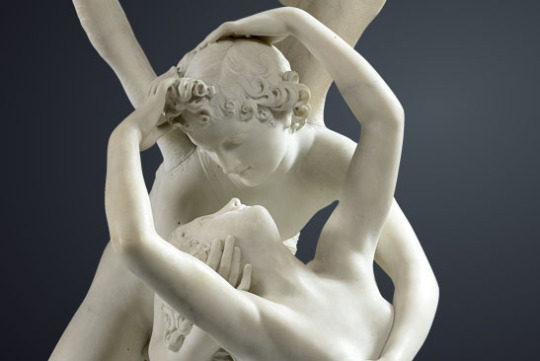
Just like Eros, Ben claws his way to his fallen lover’s side and gathers her in his arms, determined to retrieve her from death. Alive again, Rey calls Ben by his true name and professes her love in a passionate kiss. But whereas Eros then makes his soulmate immortal so that they can never be parted, Ben’s revival of her results in his own death, and the couple is again separated. Though redundant, it would be consistent with the folktale pattern for Rey to resurrect her prince in this moment. Instead, we see his body fade away, with no indication that our heroine clearly understands what has happened or really cares.
In each version of the Search for the Lost Husband, the heroine is a mortal woman who wins the love of a prince or even a god, and her final reward is to be elevated to royalty, or to immortality. Psyche becomes a goddess in her own right, dwells in the heavens, and gives birth to a daughter named Joy. Eros and Psyche, Desire and Soul, when united produce Joy.
But Rey is not united with Ben, in the end. In fact, with a royal heritage of her own, she doesn’t really need to be elevated any more. You could argue that she claims a more elevated title when she takes the Skywalker name as her own, but she still ends up alone, with only ghosts of someone else’s parents and her robot familiar for company. Rather than ascending to a throne or to the heavens, she literally descends into a ruin, a literal graveyard, in a barren wasteland. Her mythical husband is nowhere to be found, and there is no hope for a child. In a cruel and bizarre twist, TROS tells a fairly faithful final chapter of Eros and Psyche, only to strip its heroine of all she has sought in the last moment, leaving her bereft. And yet, the filmmakers dressed this as a happy ending.

TROS as an Allegory of the Lost Soul
Given how frequently the Eros and Psyche tale is used as a basis for psychoanalytic theory, what implications might this film have when viewed through that lens? In Jungian psychology, the human psyche can only achieve individuation - the knowing of oneself as a separate and unique person - if it can be separated and differentiated from the uroboric figures of parents, siblings, and mentors. Eventually, the repressed Shadow must be integrated into the Self in order for one to be a whole and healthy adult.
Within this framework, Psyche is a human soul trapped in a state of unconscious, lacking knowledge of her Shadow and therefore lacking agency. Eros is the Shadow, a collection of repressed desires which Psyche both fears and desires to claim. Her act of heroism is that same wielding of lamp and knife where she faces the truth, strips away her own illusions, and sees her Shadow for what he truly is. Psyche’s refusal to continue living a lie, and her subsequent pursuit of her desires leads her to achieve individuation signified in the product of alchemical union, Joy.

Up until the events of TROS, both Rey and Ben Solo were on this journey. Rey was trapped in a state of childlike unconscious in the graveyard of Jakku, having repressed the dark memories of the parents who abandoned her. In TFA, things tended to happen to her, but she rarely drove the action of the story herself. However, at the end of TLJ, she separated herself from the influence of uroboric mentor Luke and pursued Ben Solo, determined to truly see and claim her dark desires. With flame and steel, she stripped away the dark mask around him, but he also forced her to admit the truth about her parents to herself. Ben Solo, her animus, the projection of Rey’s unconscious, stood before her and forced her to bring what she had repressed into her conscious reality. Only then could Rey “let the past die,” separate herself from her parents, and “become what [she was] meant to be.”
Mirroring her journey, Ben was also trapped in a state of unconscious in the underworld of the Dark Side, having repressed his inclinations to the Light and to reconciliation with his family. His effort at separating himself from the influence of his mentors had a false start at first, as he mistakenly believed that he needed to “let the past die,” separating himself from his family and from the Light. With flame and steel, Ben killed his father, but to his horror, he realized that this did not rid him of his deepest desires. In TLJ, he got a second chance to separate himself from the controlling mentor by killing Snoke. Had he at that time faced his desire for the Light and acknowledged his true identity, he too would have been closer to individuation. Ben’s anima, Rey, stood before him calling him by the true name he had repressed and begging him not to stay in the Dark.
From this basis, we might assume that Rey, freed from illusions, would pursue her wayward Shadow in an attempt to integrate him. Ben, only a few steps behind, might finally accept his identity and his desire for love and affection, unite with Rey, and they would both achieve individuation, rewarded with Joy. In fact, for Ben Solo, most of this story does indeed occur in TROS. When Rey heals him and declares that she did want to take Ben’s hand, he is forced to finally face and accept his true identity. He then projects a memory of Han Solo, representing his repressed desire for the love of family, and he reconciles with himself. He then pursues his desires by running to Rey’s rescue, finally freed to act according to his own wishes. Does he manage to truly unite with her and achieve joy, though? More on that in a minute.
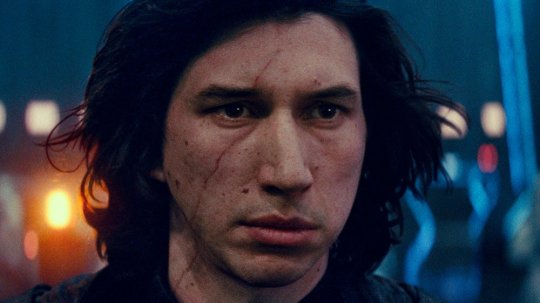
Rey, for her part, suddenly undergoes a regression into her unconscious state. Rather than becoming a unique and separate person, she again defers to mentors, training with Leia and claiming that she will “earn” Luke’s lightsaber. Consider that by the same point in his own journey, Luke was specifically defying the advice of his mentors, Yoda and Obi-Wan, who were advising him to kill his father and bury his feelings. They were of course proven wrong by the narrative, and Luke was validated. As the hero of her story and as a human psyche on its way to individuation, Rey should have separated herself from her mentors and the story should have validated her unique strengths and perspective. Instead, Rey’s success and heroism DEPEND on Luke and Leia, even to the end. In many ways, she is an avatar of her mentors more than a heroine in her own right.
The other way in which Rey regresses is in her discovery of her true parentage, as she is forced again to consider her identity as a child, an extension of the parents who (supposedly) loved her and the grandfather who might be the true source of her darkness. Recall that the action that launches Psyche’s journey into consciousness is a refusal to continue living a lie. Rey achieved this step in TLJ when Ben forced her to admit the truth to herself about her parents. Though it was painful and led to the loss of her lover just as with Psyche, it was necessary for Rey for understand that she could forge her own identity without relying on the false family she had built in her mind.
In TROS, not only is she unable to differentiate her identity from her mentors, she now has multiple new parental figures to contend with. Having accepted the truth of her deadbeat nobody parents and the losses of Han and Luke (and eventually Leia), she must now reconcile with loving somebody parents as well as having a grandfather who is basically the Satan of the Galaxy Far Far Away. Further, it seems she has been training herself to contact the spirits of many Jedi who have passed into the Force, all of whom also constitute mentors or parental figures. Rather than discovering how she is unique and what she might want in her adulthood, Rey is positively drowning in parents against whom she is derivative, still just a child.

Still, all of those parental figures are dead or die in this movie, which is traditionally one way that mythical children separate themselves from their mentors in coming-of-age tales. Theoretically, there should have been time for Rey to discover who she is apart from all these characters, decide she wanted something different out of her life, and then pursue and achieve it as heroines do. Unfortunately, we never see that happen in this film. At every point in her TROS journey, Rey is doing what a mentor instructed her to do. She’s following Leia’s guidance, or Luke’s guidance, or Palpatine’s…. In the end, it is Luke who is validated by the narrative, not Rey. She brings nothing new or unique to the galaxy, nor does she seem to have intense desires that would oppose what these mentors want for her. Yes, she did want to take Ben Solo’s hand, but she’s not on a mission to save him and she barely reacts when he gets tossed down a pit. Unlike Luke, who was determined to save Vader in spite of what everyone told him, Rey meekly follows her elders like a good girl.
In The Myth of the Birth of the Hero, Otto Rank says:
"The detachment of the growing individual from the authority of the parents is one of the most necessary, but also one of the most painful achievements of evolution. It is absolutely necessary for this detachment to take place, and it may be assumed that all normal grown individuals have accomplished it to a certain extent. Social progress is essentially based upon this opposition between the two generations. On the other hand, there exists a class of neurotics whose condition indicates that they have failed to solve this very problem."
Others have pointed out that Rey’s failure to reach full sexual maturity is also demonstrative of this problem, as evidenced by her virginal white ensemble, tight childlike buns after the soft long hair of TLJ, and loss of her intended mate at the end of the story. Rey’s journey to womanhood has been arrested in every way, but the ultimate illustration of this tragic regression is her slide down the sand when she arrives on Tatooine. To so perfectly mirror her childlike introduction on Jakku, without any reference to the later experiences that drove her toward adulthood…. It frankly suggests nothing so much as a psychotic break. In Jungian terms, Rey has been unable to break from the uroboros or collective unconscious, or to integrate her Shadow. In the loss of Ben Solo, she was unable to embrace her desires, and in taking the Skywalker name, she again lies to herself about her identity, repressing her connection to Palpatine and choosing instead a false family just as she did back on Jakku. Rather than the soul finding its way into consciousness, it is forever lost in the vast unconscious.

In a sense, Rey was not really revived after retrieving power from the Underworld after all, because she is metaphorically dead at the end of her story, just as she was metaphorically dead at its beginning. Living in the Imperial graveyard on Jakku, she had survived by remaining necessarily focused on herself. At the end of her story, she seems again focused inwardly, retreating from the galaxy and her friends, with no need to compromise or give of herself in a loving relationship with her soulmate. In Love and the Soul: Psychological Interpretations of The Eros & Psyche Myth, James Gollnick writes:
“Neumann interprets the beauty ointment which Psyche must fetch from the underworld as the eternal youth of death, the ‘barren frigid beauty of mere maidenhood, without love for a man, as exacted by the matriarchate.�� He sees in this deathlike sleep the pull of narcissism which would regress Psyche from the woman who loved Eros back to the maiden lost in the narcissistic love of herself. (Bettelheim also calls attention to the narcissistic state symbolized by Psyche alone in Eros’ magical palace, see The Uses of Enchantment.)”
This is to say that conjugal love, or a love that is physical as well as spiritual, is the ultimate form of self-gift. Though the sacrifice of one’s life is an admirable expression of love, it is inferior because it creates death, whereas the giving of self in an intimate embrace creates life. Hence, Eros and Psyche’s union created Joy. Has Rey found joy by the end of her journey? Or is she expected to be content with only power and the name that declares that power? And as for Ben, he has vanished completely. As Eros, he is dead and unable to be united with his Psyche. Though transformed from beast into man, Love is eternally separated from Soul.
When the Lost Husband Stays Lost
This might be a passable interpretation of the Sequel Trilogy, but it’s fair to ask the question: were we wrong? Was this ever a Search for the Lost Husband story, or did we simply see what we wanted to see in the tale? Indulging deeply in a Death of the Author approach to interpretation, I argue strongly that this was always a variation of ATU 425, because not only were all the pieces in place from the beginning, but the Sequel Trilogy was thematically the perfect inverse of ATU 400, the Quest for the Lost Bride, which was very clearly the story of the Prequel Trilogy. Further, many a mythical husband’s failed quest is actually the prelude to his bride’s successful search, as historical myths often start with the loss of the fairy wife only to switch perspectives to the feminine and have her successfully retrieve her lost husband. To the extent that Star Wars draws on the collective unconscious that produces these myths, I believe the parallels are unmistakable.
Still, these are films released by a corporation within a very distinct culture, the product of a particular time and place. They cannot be separated from the realities of the 21st Century America that produced them. This is why a deeper exploration of the American Monomyth is likely necessary to truly understand how TROS came to be. However, even within worldwide mythology, there are isolated examples of Lost Husband stories in which the bride does not retrieve her husband, or in which the couple remains separated by the end of the story.

One of the most notable examples of these tragedies is the Lohengrin Saga, a Germanic romance made popular by Richard Wagner’s opera. In it, Elsa, the Duchess of Brabant, is accused of murdering her brother, her case to be decided by trial by combat. When her accusers ask her who her champion will be, she tells them of a knight who has appeared to her in dreams. In answer to her prayers, her dream knight appears in a boat drawn by a swan, then agrees to be her champion under the condition that she never ask his true identity or origin. The swan knight wins the contest and marries Elsa, but before they are able to consummate their union, she asks him the forbidden question. Though he knows it will separate them forever, the knight cannot deny his love her request, and he admits to her that he is Lohengrin, Grail Knight and son of King Parzival. The laws of the Holy Grail say the Knights must remain anonymous, and if their identity is revealed, they must return home. Lohengrin leaves in the same boat in which he came, and Elsa dies of grief.
Many of the parallels should be instantly apparent: just as Kylo Ren often appears to Rey in visions, dreams, or in a dream-like state, so the Swan Knight first appeared to Elsa. As I stated in my Swan Maiden post, this means Kylo Ren is Rey’s incubus, or her dream lover and avatar of all her dark sexual fantasies. Just as the swan knight refuses to reveal his identity, so Kylo Ren declares that Ben Solo is dead and he is a monster. Further, the knight is a descendent of a powerful family, indeed one with mystical or holy origins given their association with the Grail. The last son of the Skywalker family, Ben Solo is even the great-grandson of the Force itself, with both royalty and magical power in his lineage. After several symbolic marriage encounters between Rey and her bond-mate, she insists on calling him by his true name and trying to force him to turn to the light, which constitutes the breaking of the taboo. After finally acknowledging his true identity and becoming Ben Solo once more, our hero is drawn away into death, his bride left to a sort of living death as a virgin on a dead world.

Though the story of Lohengrin predated the opera, Wagner crafted his version to explicitly reference the Greek myth of Zeus and Semele:
“Who doesn't know ‘Zeus and Semele?’ The god is in love with a human woman and approaches her in human form. The lover finds that she cannot recognize the god in this form, and demands that he should make the real sensual form of his being known. Zeus knows that she would be destroyed by the sight of his real self. He suffers in this awareness, suffers knowing that he must fulfill this demand and in doing so ruin their love. He will seal his own doom when the gleam of his godly form destroys his lover. Is the man who craves for God not destroyed?”
This too has parallels with the Sequel Trilogy couple, in particular with the woman demanding the god show himself in his “real sensual form.” As many have pointed out, Rey desired Ben completely…. His heart, mind, soul, and body. Having him with her in corporeal form mattered so much to her that the Force facilitated their touch across the galaxy, and she promptly shipped herself to him so that she could be physically with him, despite the risk to her. It is for this reason that I reject the interpretation of the ending of TROS that says because Ben and Rey are a dyad, his soul is with her when he dies. No, his loss is complete, and the fact that his body is gone is a tragedy. Were the living body not important, he would not have given his own life to save Rey’s. Absent any other visual or dialogue cues in the finale, it’s reasonable to assume that Ben’s separation from his soulmate is total.
In her book on swan maiden tales, author Barbara Fass Leavy points out that the taboos imposed on mythical husbands are different than those imposed on mythical wives. Men, for example, are most often prohibited from abusing their fairy brides, while women are prohibited from looking upon their fairy husbands or knowing their true identity. Leavy states: “In general, taboos imposed on the wife in Cupid and Psyche tales are often intended to keep her in her place, to prevent her from achieving some autonomy by knowing who her husband is, seeing him, or being able to disclose his identity to others.” Both taboos admit to an inherent imbalance in the relationship, and while husbands are instructed not to abuse their power, women are told not to challenge their husbands’ power or attempt to achieve a more balanced marriage.
Now the issue for Rey becomes clear: if she is to be her husband’s equal, then she cannot accept him as the unknowable Kylo Ren. He must become Ben Solo, fully-known and her equal in all things. This way, Rey claims her power and balance can be achieved both for the lovers and for the Force itself. Unfortunately, the creators seem to have overcorrected. They wanted Rey alone to be the ultimate hero of the Sequel Trilogy, but as long as a male Skywalker was on the board, they apparently thought he would overshadow her. It seems that the writers believed the man having power in a relationship is the natural state of heterosexual unions, a point made clear by their obsession with patriarchal lineage. So, rather than give the lovers an Eros and Psyche ending as equals, they removed the man from the equation to allow Rey to be the only hero and Skywalker, effectively punishing both of them for breaking the taboo and acknowledging Ben Solo’s true identity. When the lost husband is not found, this represents a narrative judgement on the mythical bride: she has challenged male authority, and so her heart’s desire is stripped away.

Lastly, Leavy also points out that most Beauty and the Beast tales involve a passing of the bride from father to husband, and that many animal groom stories can be interpreted as the bride learning to accept her new husband’s authority. If then the husband is eternally lost rather than found, custody of the bride logically reverts to her father. TROS contains numerous father figures for Rey: there is Luke, Palpatine’s son, and Palpatine himself. Rather than focusing on her mythical husband, our heroine seems to be questioning throughout the film to which father she truly belongs. In the end, she rejects her biological father and grandfather and loses her lover, then takes the name of her only remaining male authority figure, Luke Skywalker. Once again, Rey’s regression to a child is made clear and the myth structure utterly broken.
Conclusion: Star Wars and the Lost Children
Star Wars has always been a story of lost children. First it was Luke, then his sister Leia. Later, we learned of Anakin’s childhood, and finally Ben and Rey’s (to say nothing of other characters like Jyn, Ezra, Din Djarin….). We understood it to be a coming-of-age story in which these lonely children resolved their traumas and made adult choices. Those choices might have had sorrowful consequences, but the overall theme of the story has always been hope, so we knew there was always a chance for redemption, for the lost children to be welcomed home. Sadly, The Rise of Skywalker has deeply undermined that message. Mythologically, psychologically, and symbolically, Ben and especially Rey have reverted to childhood. They are both alone, separated from their families and prevented from forming a new family to provide hope for the future. Whereas the union of Eros and Psyche, Love and Soul, produced Joy, there is no union for Ben and Rey, and no Joy. I truly hope that in the future, Star Wars creators find a way to remedy this pandemic of lost children.
#folktale types#eros and psyche#cupid and psyche#jungian archetypes#lohengrin saga#lohengrin#zeus and semele#star wars meta#tros meta#reylo#reylo meta#the rise of skywalker#sequel trilogy#beauty and the beast#star wars#the last jedi#the force awakens#ben solo#rey#rey palpatine#psychology#romantic tragedy#atu 425#search for the lost husband#lost husband#lost bride#star wars mythology#star wars as fairy tale#greek mythology#star wars analysis
444 notes
·
View notes